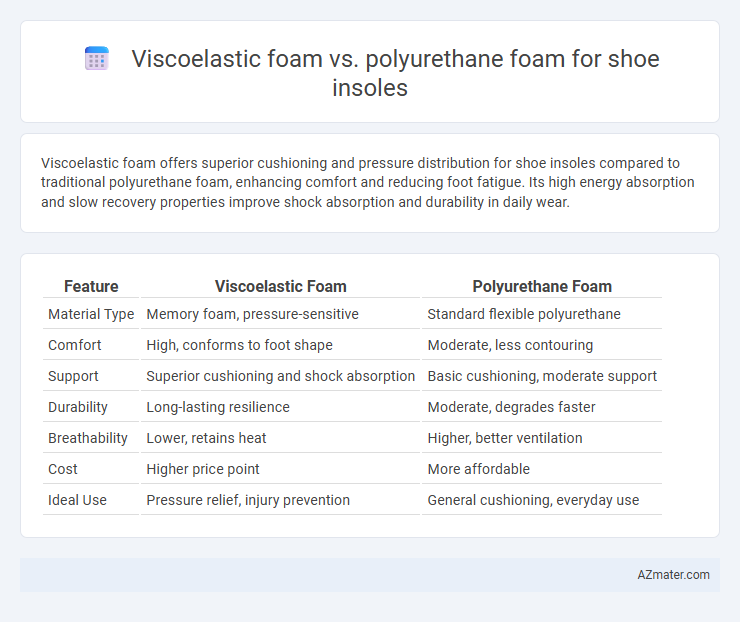Viscoelastic foam offers superior cushioning and pressure distribution for shoe insoles compared to traditional polyurethane foam, enhancing comfort and reducing foot fatigue. Its high energy absorption and slow recovery properties improve shock absorption and durability in daily wear.
Table of Comparison
| Feature | Viscoelastic Foam | Polyurethane Foam |
|---|---|---|
| Material Type | Memory foam, pressure-sensitive | Standard flexible polyurethane |
| Comfort | High, conforms to foot shape | Moderate, less contouring |
| Support | Superior cushioning and shock absorption | Basic cushioning, moderate support |
| Durability | Long-lasting resilience | Moderate, degrades faster |
| Breathability | Lower, retains heat | Higher, better ventilation |
| Cost | Higher price point | More affordable |
| Ideal Use | Pressure relief, injury prevention | General cushioning, everyday use |
Introduction to Shoe Insole Materials
Viscoelastic foam, commonly known as memory foam, offers superior cushioning and pressure distribution for shoe insoles by adapting to the foot's shape and absorbing impact effectively. Polyurethane foam, a versatile and lightweight material, provides durable support and resilience, making it widely used in budget-friendly insoles with moderate comfort and shock absorption. Both materials contribute to foot comfort but differ significantly in their mechanical properties, wear resistance, and cost, influencing the insole's performance and user experience.
What is Viscoelastic Foam?
Viscoelastic foam, commonly known as memory foam, is a polyurethane-based material with unique properties of both viscosity and elasticity, allowing it to conform closely to the foot's shape for customized cushioning. Its slow response to pressure provides superior shock absorption and pressure relief, making it ideal for reducing foot fatigue in shoe insoles. Unlike standard polyurethane foam, viscoelastic foam offers enhanced durability and comfort through its ability to distribute weight evenly and maintain its form over time.
What is Polyurethane Foam?
Polyurethane foam is a versatile synthetic material commonly used in shoe insoles due to its excellent cushioning and durability. It is created by reacting polyols and diisocyanates, resulting in a lightweight, flexible foam that provides support and shock absorption. This foam adapts to foot pressure distribution, enhancing comfort and reducing impact during walking or running activities.
Comfort Comparison: Viscoelastic vs Polyurethane Foam
Viscoelastic foam offers superior pressure distribution and adapts closely to foot contours, enhancing comfort by reducing impact and fatigue. Polyurethane foam provides firm support but lacks the conforming properties of viscoelastic materials, potentially leading to less cushioning over prolonged use. Viscoelastic foam's ability to absorb shock and return to shape makes it a preferred choice for insoles aimed at all-day comfort.
Cushioning and Shock Absorption Differences
Viscoelastic foam offers superior cushioning and shock absorption compared to polyurethane foam due to its slow recovery and pressure-relieving properties, making it ideal for shoe insoles designed for high-impact activities. Polyurethane foam provides firmer support but lacks the adaptive contouring ability of viscoelastic foam, resulting in less effective shock attenuation. The viscoelastic material's density and viscoelasticity enable enhanced energy dispersion, reducing foot fatigue during prolonged wear.
Durability and Longevity of Each Foam Type
Viscoelastic foam offers superior durability for shoe insoles due to its high-density structure, which effectively maintains shape and cushioning over prolonged use, reducing wear and tear. Polyurethane foam, while generally less dense, provides moderate durability but tends to compress and degrade faster, resulting in diminished comfort and support over time. The longevity of viscoelastic foam insoles typically exceeds that of polyurethane foam, making them a preferred choice for users seeking extended performance and sustained foot protection.
Breathability and Moisture Management
Viscoelastic foam offers superior breathability compared to polyurethane foam, thanks to its open-cell structure that enhances air circulation within the shoe insole. This enhanced airflow helps in moisture management by reducing sweat accumulation and promoting quicker evaporation, thereby maintaining a dryer, more comfortable foot environment. Polyurethane foam, with its denser cellular composition, tends to retain moisture longer, potentially leading to reduced breathability and increased risk of odor and bacterial growth.
Support and Pressure Relief Capabilities
Viscoelastic foam offers superior pressure relief by conforming closely to the foot's contours, distributing weight evenly and reducing stress on pressure points. Polyurethane foam provides firmer support with higher durability, maintaining structural integrity under prolonged use but may not contour as precisely to the foot. Viscoelastic foam excels in shock absorption and personalized comfort, whereas polyurethane foam is better suited for users requiring more stable arch support.
Cost and Affordability Analysis
Viscoelastic foam insoles generally have a higher initial cost due to advanced materials that offer superior cushioning and pressure distribution compared to standard polyurethane foam. Polyurethane foam provides a more budget-friendly option while maintaining adequate durability and comfort for everyday use. Cost-effectiveness depends on balancing comfort benefits of viscoelastic foam against the affordability and widespread availability of polyurethane foam insoles.
Which Foam is Best for Shoe Insoles?
Viscoelastic foam, often known as memory foam, offers superior cushioning and pressure relief, making it ideal for shoe insoles that require enhanced comfort and shock absorption. Polyurethane foam provides a more durable and supportive base, excelling in resilience and cost-effectiveness for everyday use. The best foam for shoe insoles depends on individual needs, with viscoelastic foam preferred for prolonged wear and comfort, while polyurethane foam suits users seeking long-lasting support and affordability.

Infographic: Viscoelastic foam vs Polyurethane foam for Shoe insole
 azmater.com
azmater.com